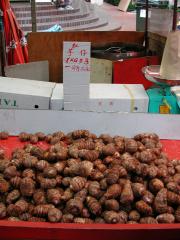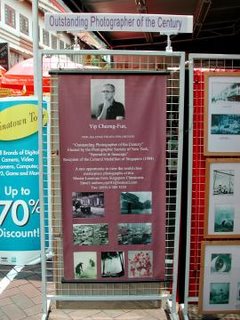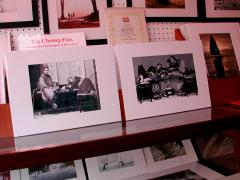 It is the time again, albeit late by one month because this year, in the Chinese Lunar Calendar there are two 7th Months. This year, the Mid-Autumn, 15th of 8th Lunar Month, falls on 6 Oct 06. Chinatown, in its tradition, is going to mark the Mid-Autumn Festival with a string of activities. It is also the time when many locals, and perhaps, foreign residents, would be queuing up the old traditional moon-cake shops such as Da Zhong Guo (Dai Chong Kok in Cantonese) known to have served many generations the Chinese pastry delights, the moon cakes being one of the major ones.
It is the time again, albeit late by one month because this year, in the Chinese Lunar Calendar there are two 7th Months. This year, the Mid-Autumn, 15th of 8th Lunar Month, falls on 6 Oct 06. Chinatown, in its tradition, is going to mark the Mid-Autumn Festival with a string of activities. It is also the time when many locals, and perhaps, foreign residents, would be queuing up the old traditional moon-cake shops such as Da Zhong Guo (Dai Chong Kok in Cantonese) known to have served many generations the Chinese pastry delights, the moon cakes being one of the major ones. 
The traditional moon cakes come baked with mostly lotus paste an salted eggs in them with a hard pastry crust. These are more Cantonese. The Teochews have their own mooncakes which are filled with yam paste and with flaky pastries. There are also the "snow-skin" types which are probably Cantonese. These days, one could find moon cake with durian flavoured fillings or Green Tea fillings.
With the moon cakes, the small yams would also be another food associated with Mid-Autumn Festival. These are steamed and eaten. And yes, the pomelos too.

For the younger kids, the lanterns are a delight. What used to be the clear see-through paper pasted on bamboo sticks with a candle holders - and they are a fire hazard, with many children crying when their lantern caught fire first - and in various shapes such as the gold fish, these days, chances are the kids would want to have those in the forms of Hallo Kitty and with electronic control bulbs that cause them to flash.
Mooncakes and pomelos are also ideal gifts by the married children to their parents, or by the boyfriends to their prospective parents-in-law. Those moon cakes with more egg yolks, the merrier.
Copied from a poster from the organisers, are the broad programme information.
Chinatown Mid-Autumn Festival 2006
Official Light-up & Opening Ceremony
23 Sep 06 Sat
7.30pm
Along New Bridge Rd
Street Light-up
23 Sep - 15 Oct 06
7.00pm - 12.00mn (Sunday to Thursday)
7.00pm - 2.00am (Friday, Saturday and eve of Public Holiday)
New Bridge Rd, Eu Tong Sen St, South Bridge rd, Pagoda St, Smith St, Sago St, Temple St and Trengganu St
Mid-Autumn Festival Celebration & Mass Lantern Walk
6 Oct 06 Fri
7.30pm
Chinatown to Singapore River
Nightly Stage Shows
23 Sep - 6 Oct 06
8.00pm - 10.30pm
Kreta Ayer Square Stage
Festival Street Bazaar
16 Sep - 6 Oct 06
11.00am - 12.00mn (Sunday and weekdays)
11.00am - 2.00am (Friday, Saturday and eve of Public Holiday)
Venue: Pagoda St, Sago St, Temple St, and Trengganu St
Heritage Night Hunt
30 Sep 06 Sat
4.30pm - 9.30pm
Chinatown
Night of Lantern Riddles
29 & 30 Sep 06 (Fri and Sat)
7.30pm - 10.00pm
Kreta Ayer Square Stage
For more information call, +65 6222 3597
Ack: Poster by Kreta Ayer-Kim Seng Citizens' Consultative Committee






